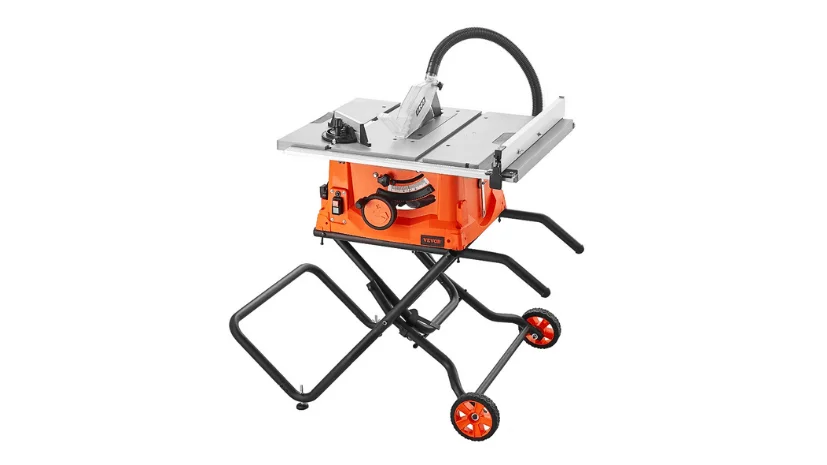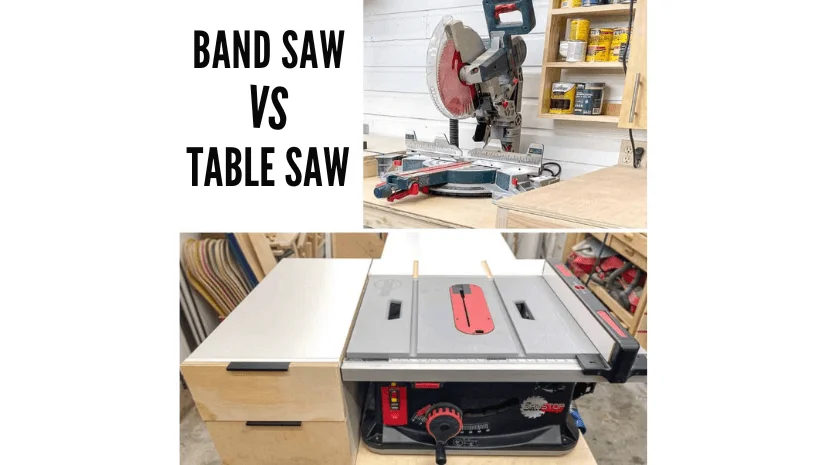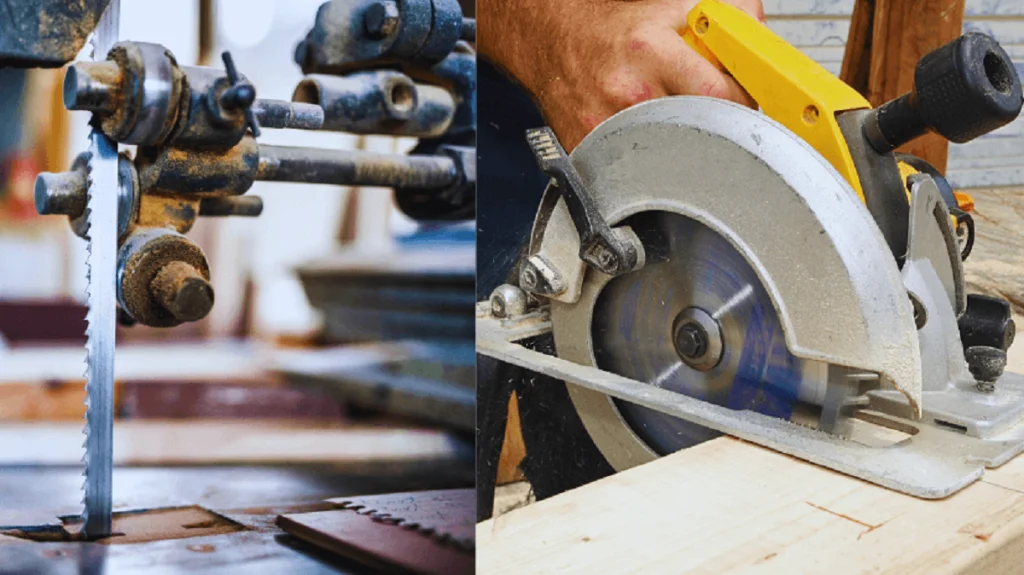Back in the days when saws were hardly used in households, you are amazed how many types of saws have come into the market since then. Choosing the right saw can make a significant impact on your work quality. Upon comparing bandsaw vs table saw, we get two popular options in craftsman tools.
What does a bandsaw do? A bandsaw is an incredible tool for cutting irregular shapes. You can achieve precision through its continuous blade attached to two wheels. Bandsaw allows you to resaw wood into thinner pieces, make veneers, and create complex scrollwork as their blades are enclosed, so cutting small pieces is safer.
Table saw vs. bandsaw is well-known for its power and efficiency in making neat, straight cuts. They’re incorporated with flat tables that vertically extend from it. Table saw vs. band saw is ideal for precisely trimming large wood sheets, cross-cutting, and cutting edges. Using a table saw vs. a bandsaw is essential while making cabinets, furniture, and other jobs that require straight and clean cutting. In this guide, you’ll learn briefly which tool is best for your woodworking needs, whether it’s bandsaw or table saw.
Table of contents
Table Saw Overview
Table saw vs. band saw is a traditional tool priority of every woodworker. But in the past, mills used large circular saws to cut wood in planks. If you want to make straight cuts, then go with a table saw. Moreover, you can find this tool in many furniture and cabinet shops. During cabinets construction, most cuts are straight, whether you’re working on plywood or slicing hardwood. That’s why every beginner woodworker loves to use this tool.

If the rip fence is used on the table or saw, ensure the workpiece edge ride against the edge should be straight. Otherwise, the workpiece can rotate once it passes by the blade. Similarly, the same goes for meter gauges for crosscutting. If you plan to use a meter gauge, ensure the edge against the meter gauge is straight, and the table saw blade spins toward the operator. It’s the blade’s teeth that spin downward to produce cutting action. So naturally, the rear blade on the saw rotates out of the table.

Common Types of Table Saw Vs. Band Saw:
Cabinet Tablesaw: They’re heavy-duty machines used for large industries’ woodworking projects. With their fully enclosed cabinets, they’re prone to dust and reduce noise levels. Cabinet saws are famous for precision, durability, and powerful motors, making them ideal for woodworkers and cabinet makers of all levels.
Contractor Tablesaw: Rather than benchtop or portable models, these table saws are the most potent tool used in small shops and on-site work. Due to their open, stand-mounted design, it’s easier to transport them than cabinet saws.
Hybrid Tablesaw: Hybrid saws combine elements of both cabinet and contractor saws, making them affordable, portable, and well performer; they’re used in small to mid-size workshops because of their lighter weight and compact size.
Advantage of Table Saw Vs. Band Saw
Table saws vs band saws offer various advantages because of their precision, versatility, and power. Here are some key aspects:
Adaptability: Tablesaws are versatile machines, and with the appropriate blades and accessories, you can perform a wide range of cuts, including cross-cutting, dado cuts, bevel cuts, and much more.
Accuracy: Table saws are renowned for their precise cutting. Its flat table surface offers a stable area and ensures you an accurate cutting every time. Having precision cuts for joinery ensures seamless connections.
Safety: All the power tools need extra care while being used, but table saws are incorporated with design features that minimize accident risk. Features like riving knives, blade guards, and kickback protection against hazards make table saws safer for performing a job.
Power: Powerful motors in table saws allow them to handle and cut material as hard as hardwood. Because of their powerful cutting capabilities, table saws are ideal for professional and hobbyists.

Understanding the Band Saw
A Bandsaw vs. Tablesaw is a handy tool with continuous metal stretched teeth between two wheels for precise cutting. Every woodworking shop utilizes bandsaws due to their unique design. Cutting curves with exceptional accuracy is the standout ability of this tool. Its constant running blade conducted by the wheels enables accurate and refined cutting along complex lines and shapes. Cutting cabriole legs, making irregular shapes, or creating scrollwork bandsaws is ideal for this task.
Besides its proficiency in cutting the band saw vs. table saw, it helps you reshape thick wood materials into smaller pieces. With its flexible, thin blade, you can cut large boards into various thinner pieces or produce consistent veneer thickness. In some specific applications, bandsaw can cut through plastic, metal, metal, and wood. This versatility makes it valuable in different industries like mills, lumber, and meat processing.
Band Saw vs Table Saw: Key Differences
Both band saws and table saws a powerful and efficient tools used for cutting various materials. Table saws and band saws can be tricky to use because, when it comes to safety, each of them has its own strength and capacity. To know which tool is best for your project, understand its capacity.
Let’s take a look at how a band saw and vs table saw are distinct from each other:
Size and Design
When it comes to design, bandsaw vs. table saw has a narrow design with a verticle blade that moves up and down. Each blade side has a large rotating wheel, while the table saw comes with a flat table surface with a horizontal blade mounted in the center. You can extend it for large work pieces.
Versatility
Band saws are versatile and capable of cutting a wide range of materials like wood, meat, and plastic. These tools are precise in cutting and handling a wide range of thicknesses. Table saw vs. band saw is exceptional for woodworking and straight cuts. However, it may have limitations while cutting thick materials or shaping curves.
Usage
The table saw is best for making cross and straight cuts with precise angles. On the other hand, band vs. table saw is ideal for curve cutting, irregular shapes, and reshaping thick materials into thinner ones.
Safety
Due to the blade’s downward cutting movement and blade guard structure, it’s considered safest for small cutting. But still, you need to be careful while making intricate cuts. However, table saw vs band saw possesses excellent features against security and allows you to work without proper safety measures. Different features like riving knives, antikickback, and blade guards help in reducing risk.
Precision
Using a band saw with proper setup and blade section can allow you to achieve accuracy. A table saw is famous for precise cutting and joinery. Equipped with components like sleds and meter gauges, it helps in attaining angles and cutting angles.
Clean Cuts
If you talk about clean cuts, bandsaws produce clean and smooth cuts, especially when equipped with sharp blades. But for thicker cuts and sanding, you need additional features. But only minimal additional features are required while using a table saw.
Material Suitability
A table saw vs Band saw is used to cut sheet goods, lumber, plywood, etc. Depending on the blade type, they’re also used to cut many other materials, so, particularly required in that project, which needs precise dimensions. A band saw curves and reshapes wood into thinner pieces. They’re suitable for plastic, metal, and wood and are used to get intricate designs and cuts.
Cost
Usually, band saws are more expensive than table saws. But the cost depends on size, brand, features, etc. A band saw with high-end features is more expensive, while a table saw costs vary on powerful motors, big tables, and advanced features. Purchasing accessories like blades and safety equipment can increase the price.
Space Requiremnets
The band saw vs. table saw has a smaller footprint, making it suitable for small spaces. The table saw needs more space due to the flat table. Larger table saws, like cabinet table saws, require a dedicated area.

When to Use Each Saw: Making the Right Choice for Your Project
Selecting a table saw or circular depends on your woodworking project requirements and limitations. For precision and large cuts, using a table saw is recommended, making it ideal for jobs like furniture-building, trim work, or creating cabinets.
At the same time, the circular saw offers flexibility and portability, making it suitable for on-site construction, DIY projects, farming, and remodeling. Its affordability makes it a first choice for those with a budget constraint. Choosing the right tool depends on many factors, such as versatility, portability, and budget.
FAQs
Q1: What are the key differences between a table saw and a circular saw?
For wood or plywood tables, saws make the best choice for getting long cuts. Tables saw is the best choice for getting identical cuts. Circular saws are preferred to get plunge and compound cuts beside wood and concrete.
Q2: Is a table saw or a circular saw better for beginners in woodworking?
A Circular saw is a great option if you’re a beginner or just starting out, but if you’ve money and space, table saws are worthwhile.
Q3: Can a circular saw perform the same tasks as a table saw?
Yes, you can be used a circular saw as a table saw with some limitations as they both can rotate and have blades.
Q4: What safety features should I look for in table saws and circular saws?
The blade guard (saw blade) is the most critical feature that efficiently keeps your fingers away from the hazard.
Conclusion
Whether you need a table or band saw depends on a few factors. Of course, you can have both if you have a space and budget. You’ll get curves and shapes of your choice, but you shouldn’t go for a band saw if you have limited space. If you do a lot of plywood cutting, then having a table saw is a great idea, like square work and making cabinets. With VEVOR’s table saw, you can cut intricate shapes or craftwork, ensuring exceptional performance.





